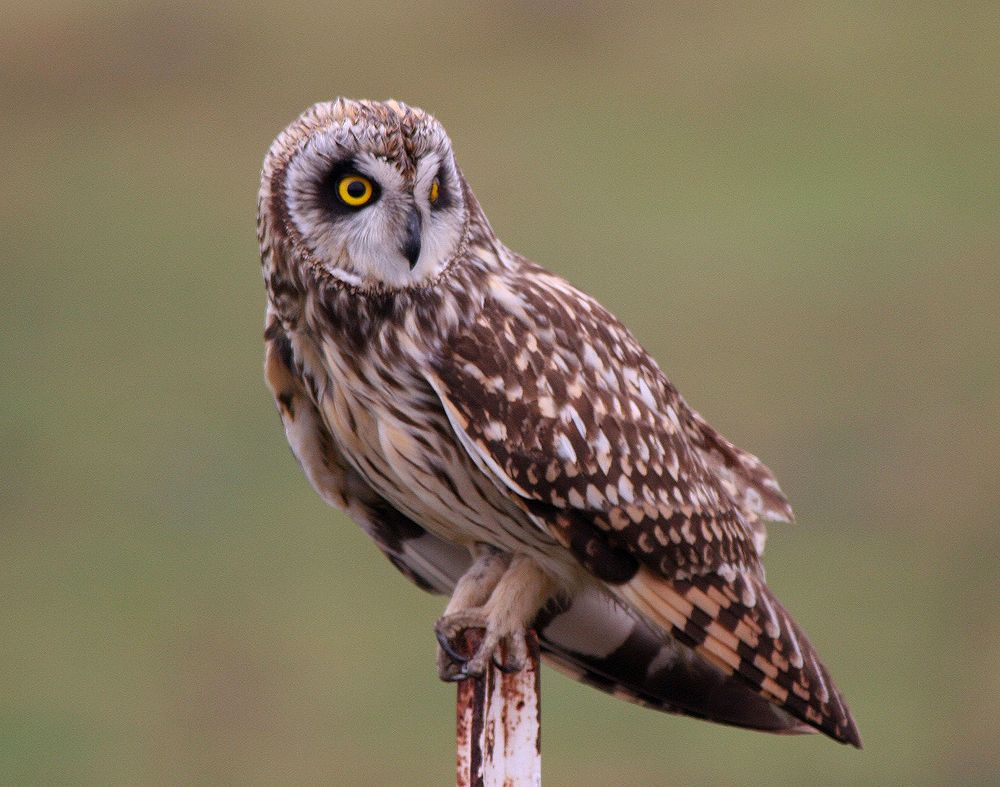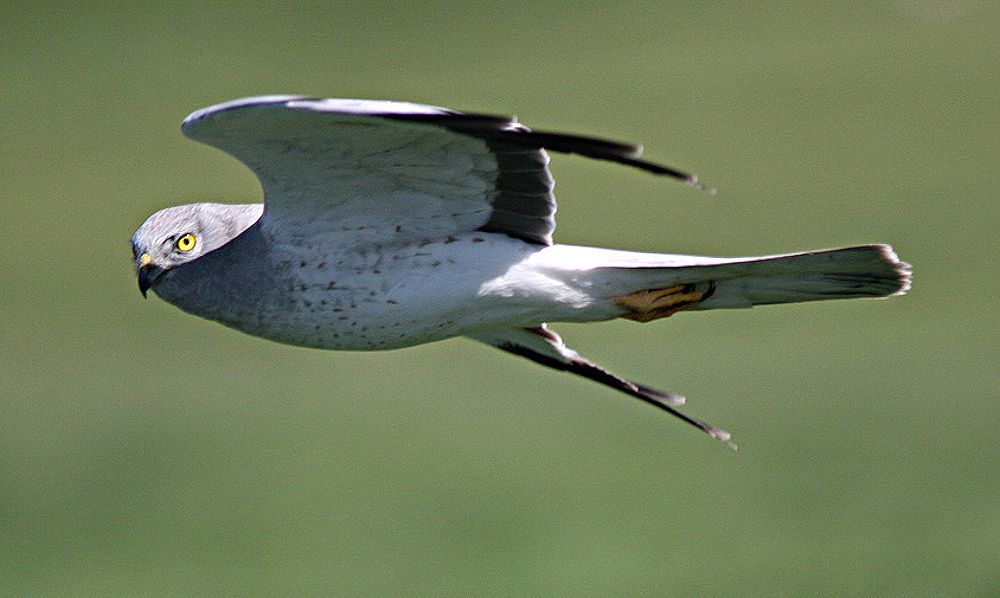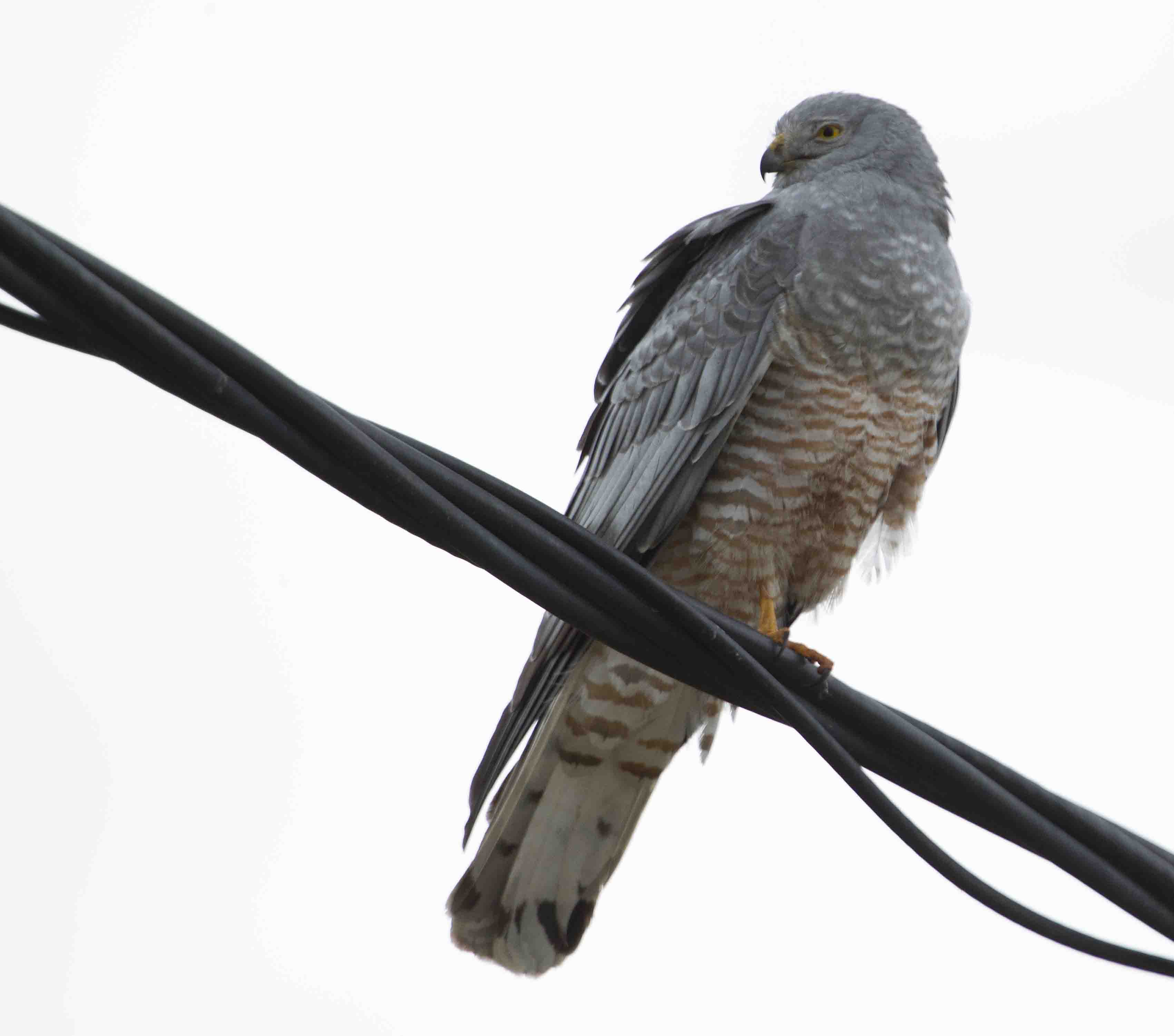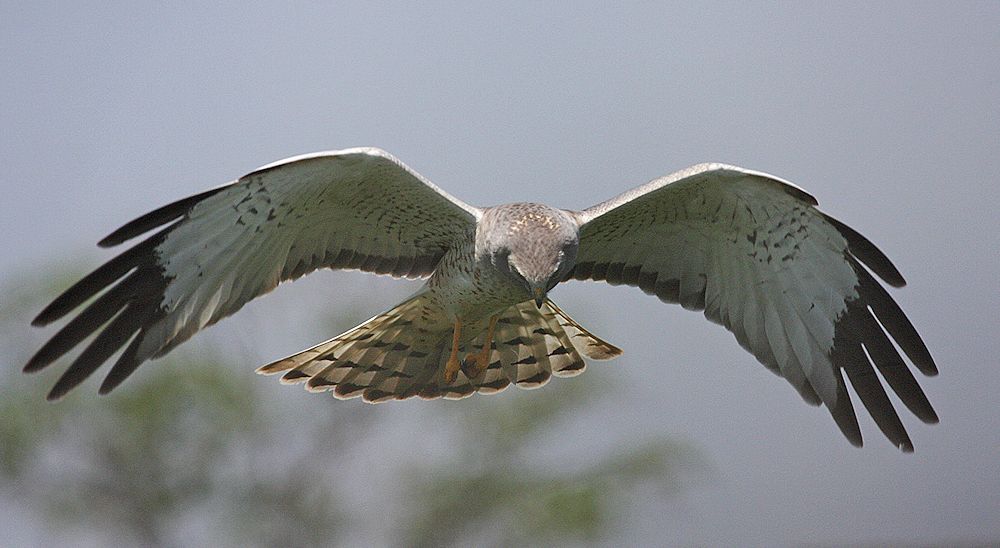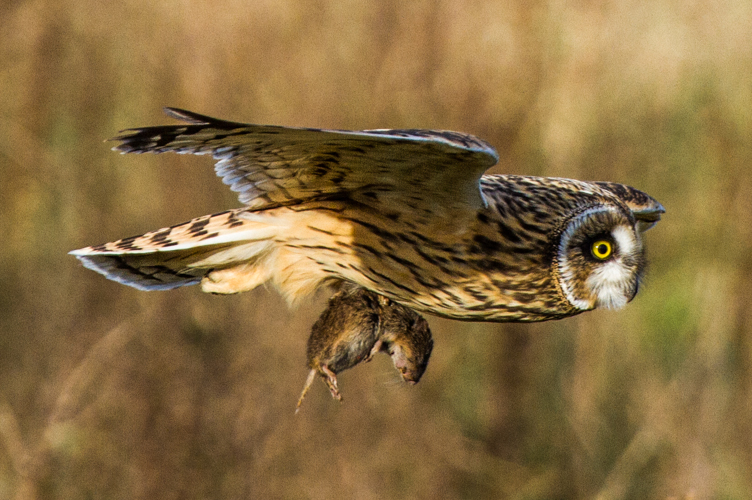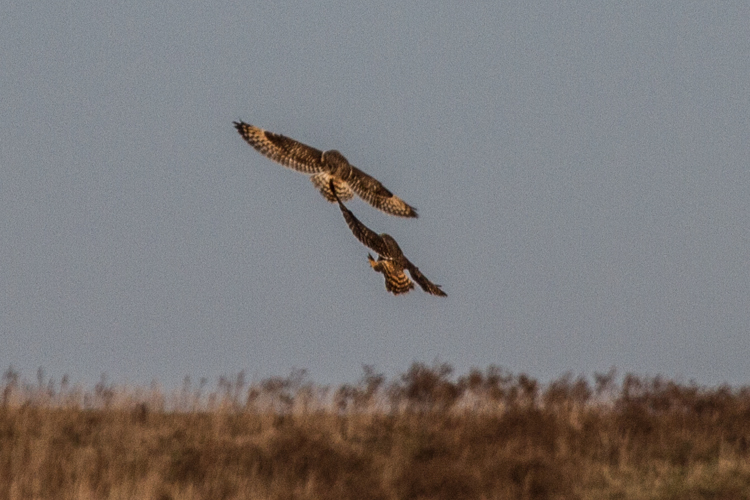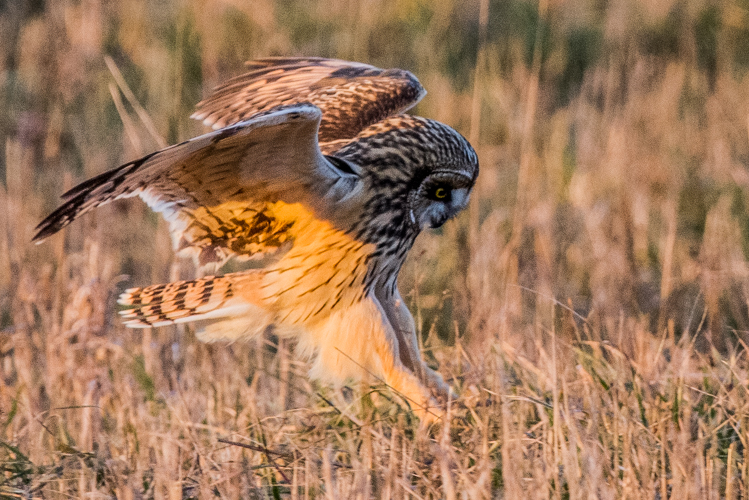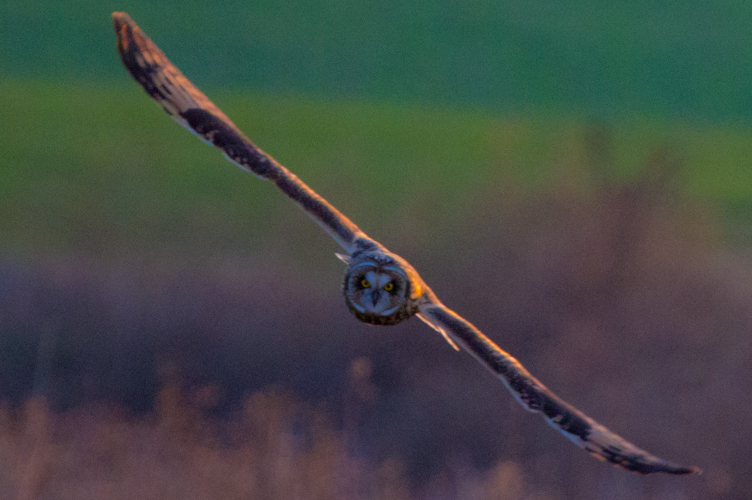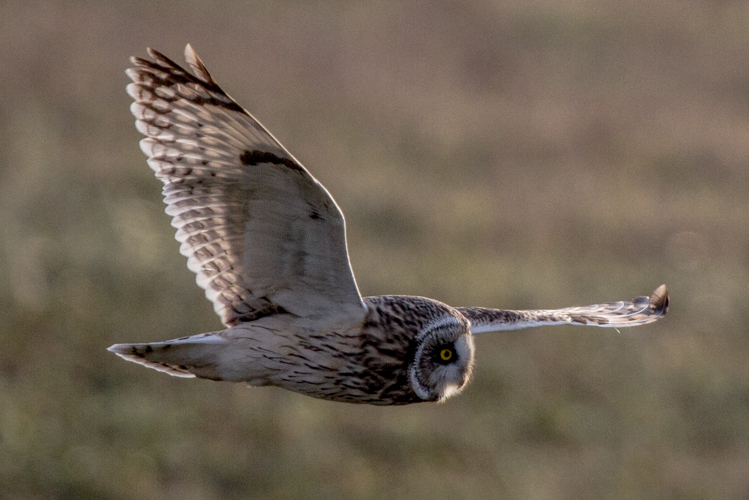by Joe Eaton
(Full article fron RATS Tales Spring 2016)
Evolution has a way of molding unrelated organisms that share an ecological niche into similar shapes. Northern harriers and short-eared owls exemplify this kind of convergence. In adapting to life in the marshes and grasslands, the two raptors have come to share a suite of anatomical and behavioral traits. The harrier has become owl-like in its reliance on hearing to detect rodent prey. The shortear, atypically for an owl, hunts at dawn and dusk, not just in darkness. Males of both species perform elaborate aerial courtship displays. And unlike most hawks and owls, harriers and shortears nest on the ground, which has affected brood size and other aspects of their life histories. In the Peterson Reference Guide to Owls, Scott Weidensaul describes them as “one of the closest nocturnal/diurnal analogs among raptors.”
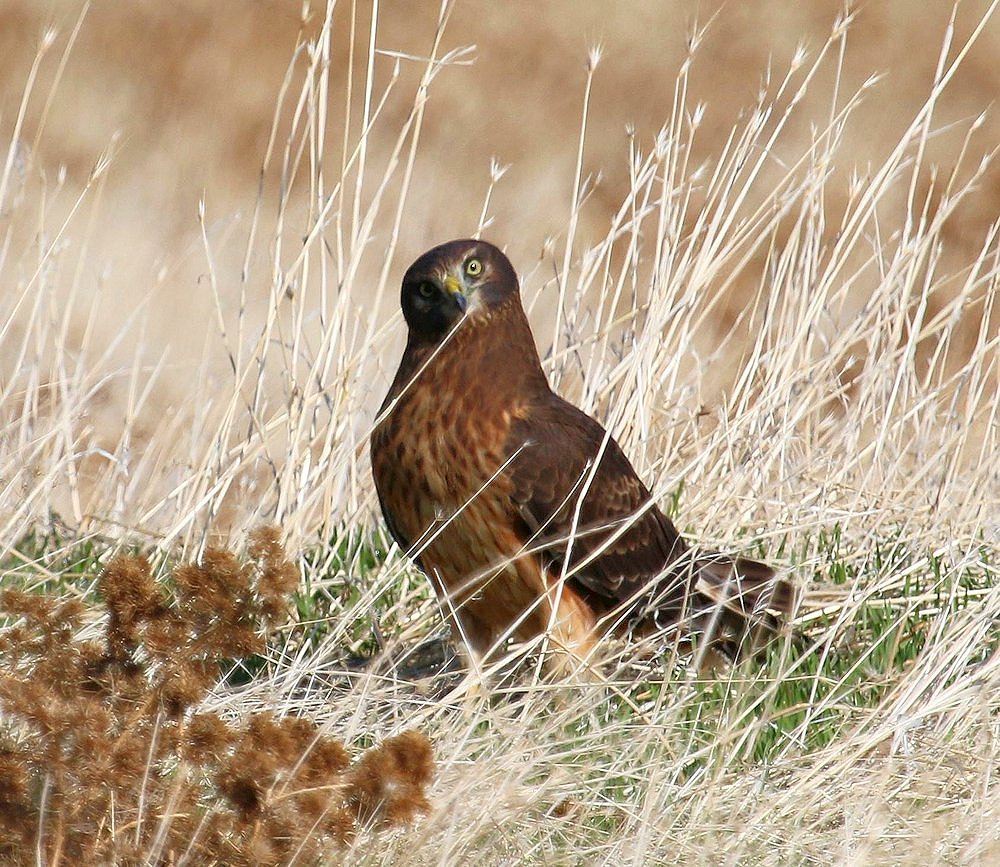 Northern harrier (all photos by Dave Harper unless otherwise indicated)
Northern harrier (all photos by Dave Harper unless otherwise indicated)
Although male northern harriers—“gray ghosts” to raptor aficionados—are distinctively patterned, the brown females and juveniles could even be mistaken for a short-eared owl. Their long-winged profiles and low flight altitudes resemble the owl’s. All harriers, though, have a white rump patch that stands out even at a distance or in poor light. Short-ears are uniformly brown above, with a dark comma at the wrist that is absent in harriers.
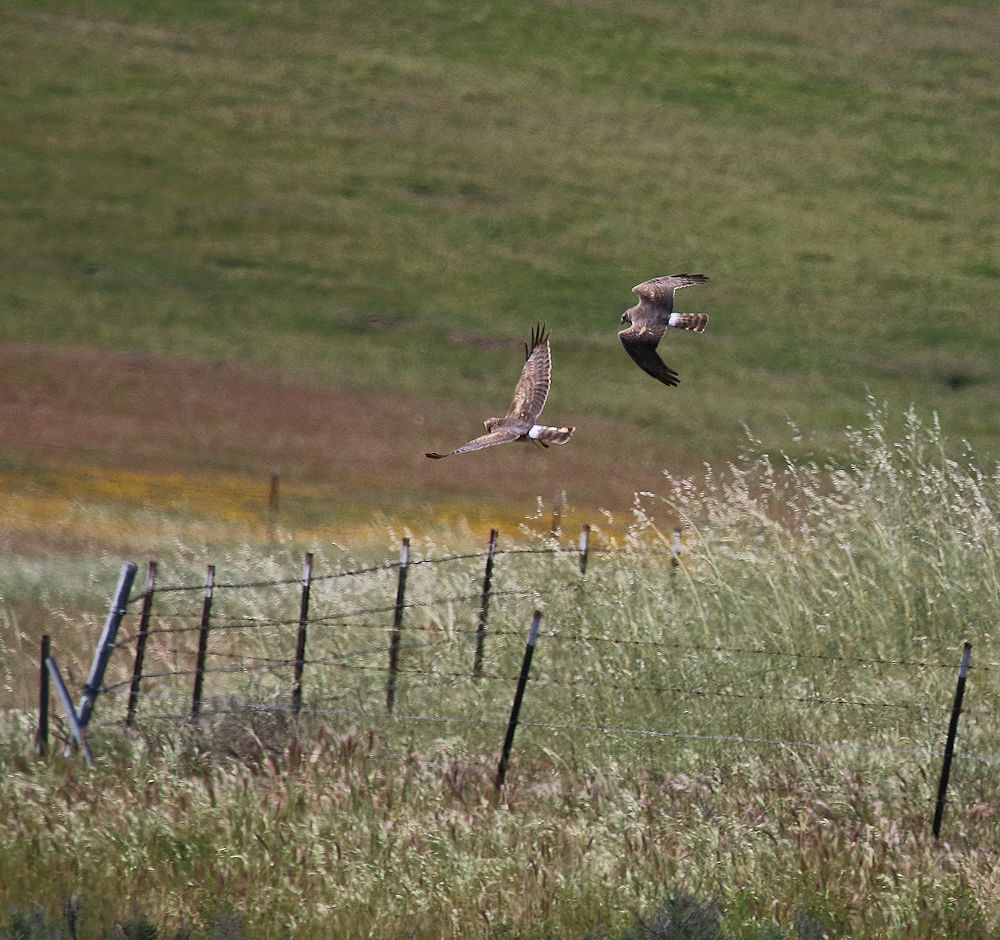 Harriers as a group—13 to 16 species, depending on who’s counting—occur on every continent except Antarctica. Robert Simmons (Harriers of the World) suggested they arose in the Southern Hemisphere, where the least specialized forms live. Their lineage split off from the forest-dwelling, short-winged accipiters, typified by the Cooper’s hawk and northern goshawk, some 5 to 7 million years ago, as the world became cooler and woods gave way to grasslands—about the time the ancestors of humans and chimpanzees went their separate ways.
Harriers as a group—13 to 16 species, depending on who’s counting—occur on every continent except Antarctica. Robert Simmons (Harriers of the World) suggested they arose in the Southern Hemisphere, where the least specialized forms live. Their lineage split off from the forest-dwelling, short-winged accipiters, typified by the Cooper’s hawk and northern goshawk, some 5 to 7 million years ago, as the world became cooler and woods gave way to grasslands—about the time the ancestors of humans and chimpanzees went their separate ways.
The cinereous harrier of South America. Photo by Jeff Robinson
Our northern harrier is considered by the American Ornithologists’ Union to belong to the same species as the Eurasian hen harrier, although some taxonomists support classifying them as separate species. (Fortunately, the AOU stopped short of adopting British nomenclature; neither form is a major threat to chickens.)
The evolutionary history of short-eared owls is less well documented, but the modern species has spread through Eurasia and the Americas and colonized the Hawai’ian, Galapagos, and Falkland islands. Although its nearest North American kin, the long-eared owl, is a nocturnal tree-nester, there are related ground-nesting crepuscular owls in sub-Saharan Africa and Central and South America.
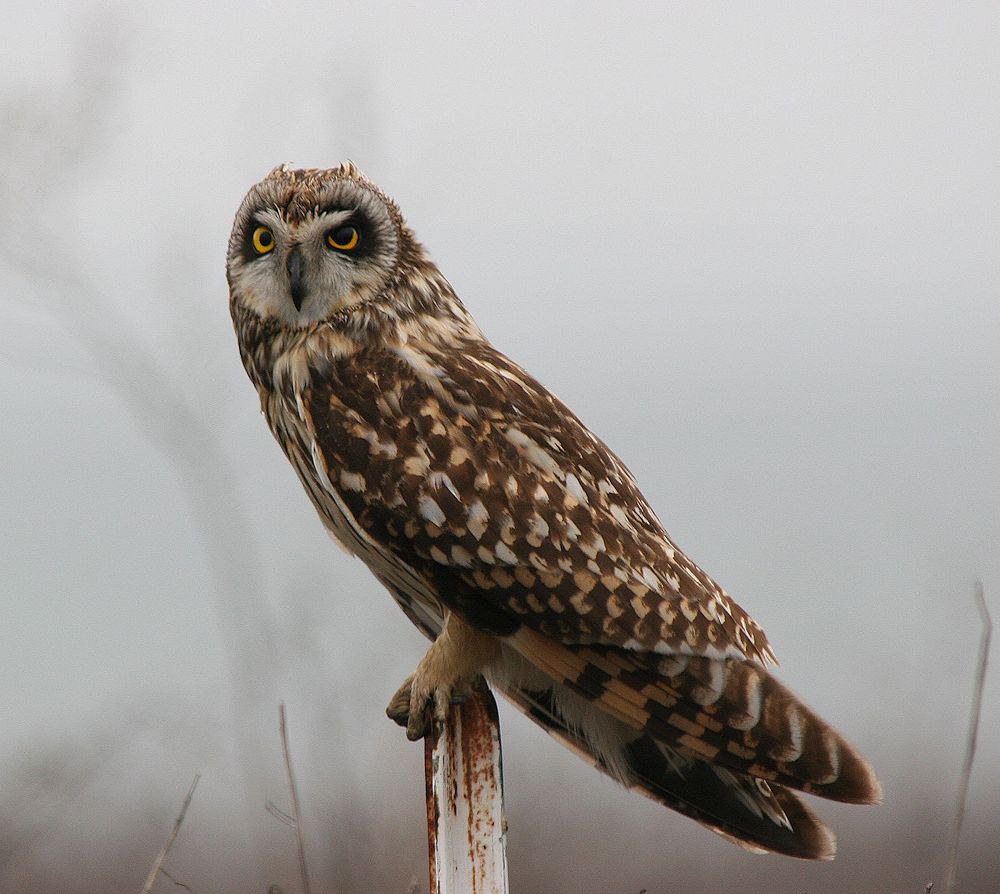 The most obvious sign of convergence between the northern harrier and the short-eared owl is the disc of stiff feathers framing the harrier’s face. The facial ruff is believed to concentrate sound, enabling a hunting harrier to pick up the rustles and squeaks of unseen prey. In some harrier species, the ruff can be expanded and contracted. Owls have a more sophisticated sound-detection system, with asymmetrical ear placement that helps triangulate a source. William Rice confirmed the northern harrier’s acute hearing in field and laboratory research for his PhD at Oregon State University in the early 1980s. His subjects, although resistant to training, performed as well as barn owls and significantly better than red-tailed hawks and American kestrels in homing in on recorded vole noises.
The most obvious sign of convergence between the northern harrier and the short-eared owl is the disc of stiff feathers framing the harrier’s face. The facial ruff is believed to concentrate sound, enabling a hunting harrier to pick up the rustles and squeaks of unseen prey. In some harrier species, the ruff can be expanded and contracted. Owls have a more sophisticated sound-detection system, with asymmetrical ear placement that helps triangulate a source. William Rice confirmed the northern harrier’s acute hearing in field and laboratory research for his PhD at Oregon State University in the early 1980s. His subjects, although resistant to training, performed as well as barn owls and significantly better than red-tailed hawks and American kestrels in homing in on recorded vole noises.
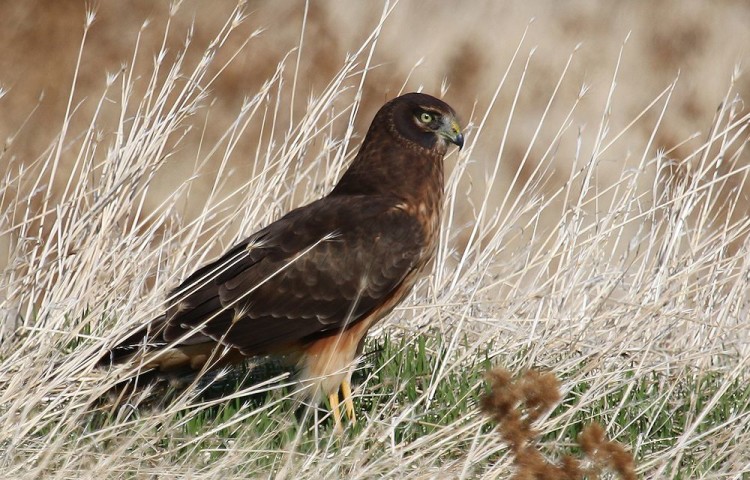
During the breeding season, voles may make up the bulk of a harrier’s catch. Published studies range from a high of 70 percent in New Brunswick to a low of 5 percent in California. In a long-term project in Wisconsin, Frances Hamerstrom found that harrier reproductive success closely tracked vole populations. Harriers may also take a significant number of birds, from blackbirds and sparrows up to small waterfowl. Coots are challenging: twice I’ve watched a harrier that had killed one struggle in vain to take off with it. Whether hunting by eye or by ear, harriers are adaptable and resourceful. “A lazy, loafing, desultory flight it seems,” writes Arthur Cleveland Bent in Life Histories of North American Birds of Prey, “but really it is full of purpose, as it quarters low over the ground in a systematic search for its prey.” Harriers have been seen following fencerows, ditches, or roadsides; hunting at the edge of fires, to catch prey rousted by the flames; scouting newly-mown hayfields for exposed nests; following foxes to pick up whatever they flush; even foraging in active bombing ranges.
Compared with harriers, short-eared owls are more strictly rodent specialists. Voles predominate, supplemented by gophers, lemmings, kangaroo rats, shrews, moles, and rabbits; in most populations studied, mammals account for at least 95 percent of prey taken. Shortears in coastal areas are most likely to prey on birds, including shorebirds, rails, and songbirds. In a study at Bolinas Lagoon in 1971-73, the owls were found to take mainly dunlin, followed by varied thrushes. Their hunting pattern is much like a harrier’s: low, quartering flights, occasionally hovering.
Although they work the same territory, these two raptors seem to avoid direct competition. One study found only a 17 percent overlap in prey species, noting that female harriers, larger than either males or short-ears of either sex, take bigger prey, and that harriers tend to raise their young later in the year than short-ears.
Mating season is when northern harriers and short-eared owls display their stunt-flying kills. William Leon Dawson (The Birds of California) describes the “astonishing aerial evolutions” of the male harrier: “He soars about at a great height, screaming like a falcon; or he suddenly lets go and comes tumbling out of space head over heels, only to pull up at a safe distance from the ground and listen to the admiring shrieks of his spouse.” Males also perform extended roller-coaster flights. Prospective mates may watch from a perch or follow behind the male as if evaluating his performance. In his version of the sky-dance, a male short-eared owl soars high, then, according to Hans Peeters (Field Guide to Owls of California and the West), “performs a shallow stoop ending in an upward swoop during which he claps his wings below his body.” The sound has been likened to a whipcrack or a flag fluttering in the wind.
The mating season can be strenuous for some male northern harriers: they may have up to five mates, with favored females getting preferential rodent deliveries as they incubate—not such a good deal for the others. Polygyny has also been observed in several Eurasian harrier species. In Europe, some male western marsh-harriers have female-like plumage that lets them sneak past territorial males and fraternize with their mates. While short-eared owls seem to be more monogamous, anecdotal reports of two males defending the same territory or two females tending the same nest suggest an occasional ménage a trois. For both harriers and short-ears, pair formation is short-term, seldom lasting more than a year.
Owls and hawks tend to prefer nest sites well above the ground—trees, cliffs, elevated human structures. Here again, harriers and short-eared owls are atypical. Except for the tree-nesting spotted harrier of Australia, all the world’s harrier species are ground-nesters, as are the short-eared owl and some of its tropical relatives. While most other owls lay their eggs on the bare substrate, female short-ears line a scrape in the earth with grass and feathers. Both male and female harriers collect plant material for nest construction, the female building up the platform and lining the interior. Clutch size averages 4.4 eggs in northern harriers, high for a hawk (for red-tailed hawks it’s closer to 2.5), probably insurance against nest predation by coyotes, foxes, and skunks. Short-eared owls lay an average of 5.6 eggs, consistent with the larger clutch size of most owls. Young owls grow fast and get out as early as they can, dispersing even before they can fly, and harrier nestlings are also relatively mobile. Both species require some kind of vegetative cover; in Solano County, shortears have nested in sugar beet fields.
Harriers are often aggressive toward other raptors; a few weeks ago I saw one, probably a foolhardy juvenile, buzz a peregrine falcon. But they seem to tolerate the presence of short-eared owls and often share night roosts with them. When competition for prey becomes intense, northern harriers may pirate the owls’ food.
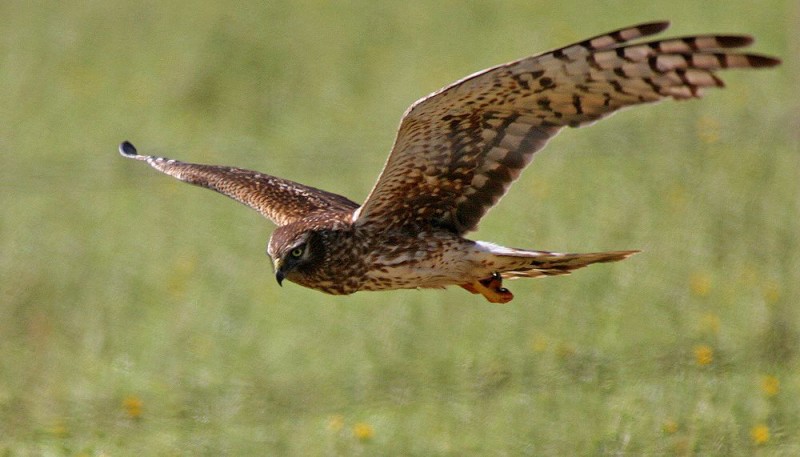 Given the fate of North America’s grasslands and wetlands, it’s no surprise that northern harriers and short-eared owls are in trouble. Both are listed as Species of Special Concern in California, where harriers have been extirpated from parts of the southern coastal region, and short-ears have become rare breeders on the central coast and in the southern half of the state. Conversion from other agricultural uses to orchards and vineyards continues to eliminate breeding and foraging habitat. Several eastern and midwestern states classify the harrier as endangered or threatened; the owl has a special-status designation in 26 states and 6 Canadian provinces. Conservation planning is complicated by the nomadic tendencies of both species, particularly the owl.
Given the fate of North America’s grasslands and wetlands, it’s no surprise that northern harriers and short-eared owls are in trouble. Both are listed as Species of Special Concern in California, where harriers have been extirpated from parts of the southern coastal region, and short-ears have become rare breeders on the central coast and in the southern half of the state. Conversion from other agricultural uses to orchards and vineyards continues to eliminate breeding and foraging habitat. Several eastern and midwestern states classify the harrier as endangered or threatened; the owl has a special-status designation in 26 states and 6 Canadian provinces. Conservation planning is complicated by the nomadic tendencies of both species, particularly the owl.
Harriers are known to have been impacted by DDT in the 1950s and 60s. There’s little data on the effects of rodenticides on either species. As rodent predators, though, both the owl and the harrier must be considered at risk from secondary poisoning by anticoagulant rodenticides.

